Related Research Articles

Beer is one of the oldest alcoholic drinks in the world, the most widely consumed, and the third most popular drink after water and tea. Beer is produced by the brewing and fermentation of starches from cereal grains—most commonly malted barley, although wheat, maize (corn), rice, and oats are also used. The fermentation of the starch sugars in the wort produces ethanol and carbonation in the beer. Most modern beer is brewed with hops, which add bitterness and other flavours and act as a natural preservative and stabilising agent. Other flavouring agents, such as gruit, herbs, or fruits, may be included or used instead of hops. In commercial brewing, natural carbonation is often replaced with forced carbonation.
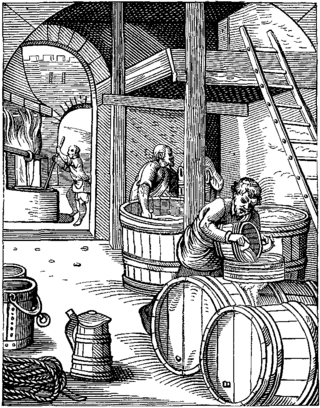
Brewing is the production of beer by steeping a starch source in water and fermenting the resulting sweet liquid with yeast. It may be done in a brewery by a commercial brewer, at home by a homebrewer, or communally. Brewing has taken place since around the 6th millennium BC, and archaeological evidence suggests that emerging civilizations, including ancient Egypt, China, and Mesopotamia, brewed beer. Since the nineteenth century the brewing industry has been part of most western economies.

Mead, also called hydromel, is an alcoholic beverage made by fermenting honey mixed with water, and sometimes with added ingredients such as fruits, spices, grains, or hops. The alcoholic content ranges from about 3.5% ABV to more than 20%. The defining characteristic of mead is that the majority of the beverage's fermentable sugar is derived from honey. It may be still, carbonated, or naturally sparkling; dry, semi-sweet, or sweet.
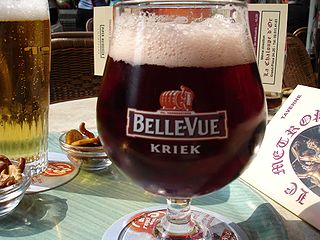
Kriek lambic is a style of Belgian beer, made by fermenting lambic with sour Morello cherries. Traditionally "Schaarbeekse krieken" from the area around Brussels are used. As the Schaarbeek type cherries have become more difficult to find, some brewers have replaced these with other varieties of sour cherries, sometimes imported.

Lambic is a type of beer brewed in the Pajottenland region of Belgium southwest of Brussels and in Brussels itself since the 13th century. Types of lambic beers include gueuze, kriek lambic, and framboise. Lambic differs from most other beers in that it is fermented through exposure to wild yeasts and bacteria native to the Zenne valley, as opposed to exposure to carefully cultivated strains of brewer's yeast. This process gives the beer its distinctive flavour: dry, vinous, and cidery, often with a tart aftertaste.
Big Rock Brewery is a Canadian public company and the largest brewery that is based in Calgary, Alberta, Canada. As of March 2020, it was also Canada's largest craft brewery. Additional brewing operations are located in Vancouver, British Columbia; Etobicoke, Ontario; and Liberty Village in Toronto, Ontario. Big Rock distributes a variety of beers and ciders throughout Canada.

Fruit wines are fermented alcoholic beverages made from a variety of base ingredients ; they may also have additional flavors taken from fruits, flowers, and herbs. This definition is sometimes broadened to include any alcoholic fermented beverage except beer. For historical reasons, mead, cider, and perry are also excluded from the definition of fruit wine.

Framboise is a Belgian lambic beer fermented with raspberry.

Alken-Maes is a Belgian brewery created out of the 1988 merger of two small breweries, Maes located at Kontich-Waarloos and Cristal-Alken located at Alken. It was bought by Scottish & Newcastle in 2000, who were taken over by Carlsberg and Heineken in 2007.
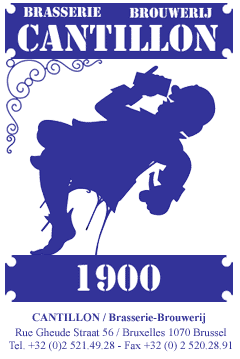
Brasserie-Brouwerij Cantillon is a small Belgian traditional family brewery based in Anderlecht, Brussels. Cantillon was founded in 1900 and brews exclusively lambic beers.

Belle-Vue Brewery is a brewery founded in 1913 in Molenbeek, Brussels by Philémon Vandenstock from nearby Itterbeek, which lies in a region known for its lambic type of beer. A variety of Belle-Vue lambic and fruit beers are produced in Sint-Pieters-Leeuw.

Beer in Belgium includes pale ales, lambics, Flemish red ales, sour brown ales, strong ales and stouts. In 2018, there were 304 breweries in Belgium, including international companies, such as AB InBev, and traditional breweries, such as Trappist monasteries. On average, Belgians drink 68 litres of beer each year, down from around 200 each year in 1900. Most beers are bought or served in bottles, rather than cans, and almost every beer has its own branded, sometimes uniquely shaped, glass. In 2016, UNESCO inscribed Belgian beer culture on their list of the intangible cultural heritage of humanity.

In brewing, adjuncts are unmalted grains or grain products used in brewing beer which supplement the main mash ingredient. This is often done with the intention of cutting costs, but sometimes also to create an additional feature, such as better foam retention, flavours or nutritional value or additives. Both solid and liquid adjuncts are commonly used.
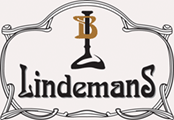
Lindemans Brewery is a Belgian family brewery based in Vlezenbeek, a small town in Flemish Brabant, southwestern Brussels. It produces lambics, a style of Belgian ale that uses raw wheat and wild yeast.

Beer styles differentiate and categorise beers by colour, flavour, strength, ingredients, production method, recipe, history, or origin.

Oud Beersel is a Belgian lambic brewery. It is a member of HORAL, whose main event is Toer De Geuze every two years.

A bombe glacée, or simply a bombe, is a French ice cream dessert frozen in a spherical mould so as to resemble a cannonball, hence the name ice cream bomb. Escoffier gives over sixty recipes for bombes in Le Guide culinaire. The dessert appeared on restaurant menus as early as 1882.

Cherry juice is a fruit juice consisting of the juice of cherries. It is consumed as a beverage and used as an ingredient in various foods, processed foods and beverages. It is also marketed as a health supplement. It is produced by hot- or cold-pressing cherries, collecting the juice, and then filtering and pasteurizing it.
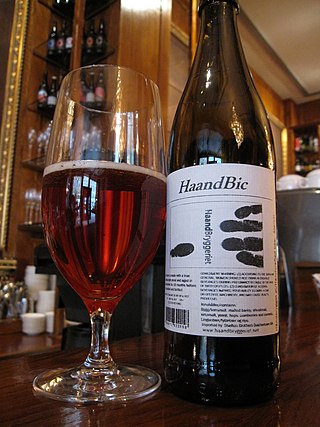
Sour beer is beer which has an intentionally acidic, tart, or sour taste. Sour beer styles include Belgian lambics and Flanders red ale and German Gose and Berliner Weisse.
A seasonal beer is a beer that is typically brewed during or for a particular season, holiday or festival period. Many breweries produce seasonal beers. Seasonal beers may be produced when fresh ingredients are available during various seasons, per climatic conditions during the time of the year, and also as a tradition. Furthermore, seasonal beer is produced based upon seasons, holidays, festivals and events.
References
- ↑ Garrett Oliver (9 Sep 2011). The Oxford Companion to Beer. Oxford University Press. p. 445. ISBN 9780195367133.
- ↑ Garrett Oliver (9 Sep 2011). The Oxford Companion to Beer. Oxford University Press. p. 552.
- ↑ Garrett Oliver (9 Sep 2011). The Oxford Companion to Beer. Oxford University Press. p. 373.
- ↑ "Fruitbier.be". Archived from the original on 2018-08-03. Retrieved 2019-12-22.